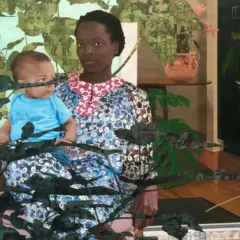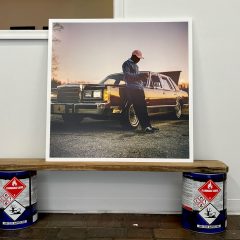[Josh finds personal connections to a show of recent work by international artist Thomas Schütte. — the Artblog editors]
At the current Thomas Schütte exhibition at Peter Freeman gallery in New York, faces abound. One cannot help but think of the opening lines to the song “Mad World” by Gary Jules: “All around me are familiar faces / Worn-out places, worn-out faces / Bright and early for the daily races / Going nowhere, going nowhere”. These many tired and familiar faces confront the viewer in this multimedium exhibition comprised of prints, ceramic, and installation.
Heads first
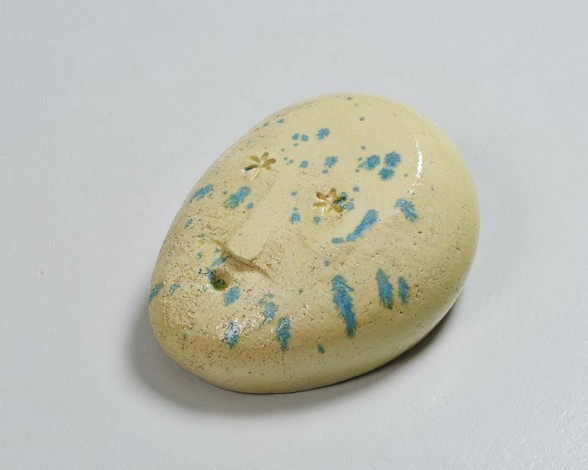
The current exhibition focuses on new ceramics completed in 2014–Eierköpfe (eggheads)–20 of which were chosen by the artist for this show, along with two larger ceramic heads of a man and a woman from 2011. One cannot help be reminded of Brancusi’s obsession with heads in the early 20th century. With some of Brancusi’s heads completed over a century ago, it is fascinating to see that some artists’ interest in faces and physiognomy has only grown stronger. While Brancusi chose to sculpt his heads in several different media, Schütte composes all of his eggheads in glazed ceramic. He adds variety to his work by changing the color of the paint, the texture of the ceramic, and the positioning of the facial features.
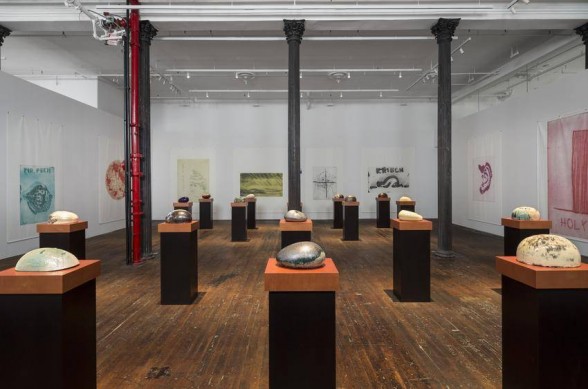
Looking upon the eggheads as a group, they seem overwhelmingly similar; however, upon closer inspection, each face is unique and unlike any other. Although each head has a personalized physiognomy and mood, the placement and curation makes them seem stale and humdrum. Here, Schütte plays with the idea of serial reproduction, as evidenced by the monotony of the gallery’s layout. These are the worn-out faces … going nowhere. Exhibited in a city of eight million residents, this is an appropriate dichotomy. Although each person is an individual, the monotony inherent in the daily grind of the city can create people who often blindly perform the actions that need to be done to get through the day.
Banner days
In addition to the eggheads, Schütte has chosen several large banners upon which were printed images from the artist’s Wattwanderung (Low Tide Wandering) series of 139 etchings, from which the artist selected 21 for this show. The banners lack individual titles, and rather are presented as a collective group. The etchings began as a diaristic project following the atrocities of September 11, 2001. As such, the mood that they convey is clear: deep etch marks incise the surface, and brooding loops complement the marks. Empty faces stare down the viewer while nude women sit and wait in promiscuous poses. Another banner boasts tally marks, positioning the viewer in the perspective of a prisoner, marking days of the week as his isolation passes.
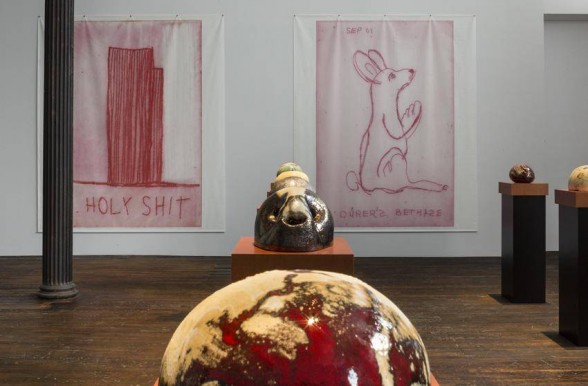
If the imagery of these banners was not clear enough, the phrases that he sometimes includes cast away any shadow of a doubt. He uses both English and German to remind the viewer that anything can happen. A man with excrement on his head is paired with the phrase “shit happens”. A set of crosshairs superimposes a ragged-looking character with the categories of “rich” and “poor” pasted over his face. A barren, abstract landscape with deep incisions is stamped with “atmen nicht vergessen” (don’t forget to breathe).
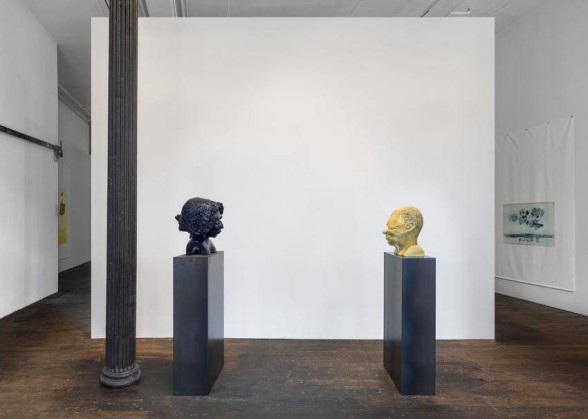
Entering the gallery is a welcome respite from the caterwauling and frenzy of SoHo. The dim lighting is cool and welcoming, while the repetitive nature of the curation is rhythmic and calming. After being seduced into the space, the viewer is presented with himself, per se. The eggheads stand as commentary on the serialized nature of living in New York, or any major city, for that matter. We become one of many numbers of people. The banners that dangle from above emulate our deepest feelings and concerns. It is what worries us and keeps us up at night. However, the eggheads also offer us a sense of comfort, reminding us that no matter how alone and burdened we may feel, there is certainly someone else nearby to commiserate and help carry the load.
This is the first time Schütte has exhibited new work in New York since his previous solo show at Peter Freeman in 2012. He is a world-renowned artist who has been exhibiting in Europe and America since the 1980s. Born in Oldenburg, Germany in 1954, he studied at the Kunstakademia of Dusseldorf, the city where he still lives and works. Schütte has recently had solo exhibitions at Fondation Beyeler, Riehen, Switzerland (2013-2014), Museum Folkwang, Essen, Germany (2013), and Serpentine Gallery, London (2012), and his work has been the focus of three different recent retrospectives held in Bonn (2010), Madrid (2010), and Munich (2009). His work is included in the permanent collections of major international museums, including: Centre Georges Pompidou, Paris; Reina Sofia, Madrid; Tate Modern, London; Dallas Museum of Art; Art Institute of Chicago; San Francisco Museum of Modern Art; and Museum of Modern Art, New York.
The exhibition on Thomas Schütte will run through May 30, 2015 at Peter Freeman, 140 Grand St., New York, N.Y.



